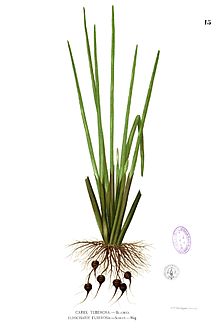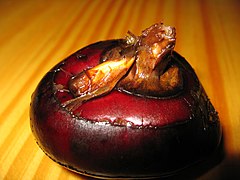The
Chinese water chestnut (
Eleocharis dulcis;
synonyms E. equisetina,
E. indica,
E. plantaginea,
E. plantaginoides,
E. tuberosa,
E. tumida), more often called simply the
water chestnut, is a grass-like
sedge grown for its edible
corms. The water chestnut is actually not a
nut at all, but an
aquatic vegetable that grows in
marshes, underwater in the mud. It has tube-shaped, leafless green stems that grow to about 1.5 metres. The
water caltrop, which is also referred to by the same name, is unrelated and often confused with the water chestnut.
The small, rounded corms have a crispy white flesh and can be eaten raw, slightly boiled, grilled, pickled, or
tinned. They are a popular ingredient in Chinese dishes. In China, they are most often eaten raw, sometimes sweetened. They can also be ground into a
flour form used for making
water chestnut cake, which is common as part of
dim sum cuisine. They are unusual among vegetables for remaining crisp even after being cooked or canned, because their cell walls are cross-linked and strengthened by certain
phenolic compounds. This property is shared by other vegetables that remain crisp in this manner, including the
tiger nut and
lotus root.
[1]
The corms are rich in
carbohydrates (about 90 percent by dry weight), especially
starch (about 60 percent by dry weight), and are also a good source of
dietary fiber,
riboflavin,
vitamin B6,
potassium,
copper, and
manganese.
[2]
If eaten uncooked, the surface of the plants can transmit
Fasciolopsiasis.
| Contents- 1 Taste
- 2 In other languages
|
Taste
Raw water chestnuts are slightly sweet and very crunchy. Boiled water chestnuts have a firm, and slightly crunchy texture, with a flavor that is very mild, slightly nutty in taste, so it is easily overpowered by any seasonings or sauces the water chestnut is served or cooked with. Water chestnut are often combined with
bamboo shoots,
cilantro,
ginger,
sesame oil, and
snow peas. It is often used in
pasta or
rice dishes.
[3]
In other languages
The Chinese water chestnut (traditional Chinese:
荸薺; simplified Chinese:
荸荠;
hanyu pinyin: bíqi,
馬蹄;
pinyin:mǎtí) is native to
China and is widely cultivated in flooded
paddy fields in southern China and parts of the
Philippines. In
Vietnam, it is called
củ mã thầy (in the North) and
củ năng (in the South) and is the main ingredient of
bánh củ năng hấp, chè mã thầy. In
Thailand it is called
somwang (สมหวัง) and it is often used in dessert as
tabtim krob (ทับทิมกรอบ). In India it is commonly known as Singaga, shingada or singoda.



No comments:
Post a Comment